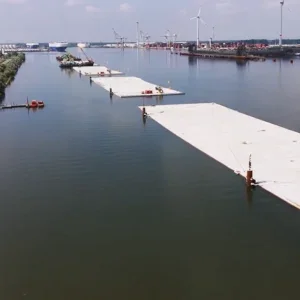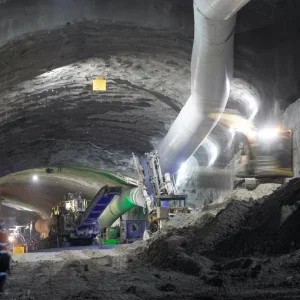"In Europe the market is dropping. China is the clear leader for tunnelling in the world and the rest of Asia is strong. Here we are growing – fast. In maybe five years South America will have surpassed Europe for tunnelling demand and there is work for everyone."
So says Rolando Justa who was brought in by Robbins last August to head up the company’s new office in Chile. His official statement on the opening of the office explains that "setting up an office in this region was important to us because a close and constant approach with our clients is essential in the Latin American market."
Location, location, location
"We looked at the South American market carefully for a length of time to decide where to locate our base of operations. We have great expectations for Chile, though it was a very difficult choice between Chile and Brazil. There were similar opportunities from both countries that we set out as the two main opportunities for us.
"In the end, we reasoned that Chile (and nearby Peru) will have more hard rock projects, which we have a lot of experience with and are more likely to win.
"There are big plans in all these places that we know are coming up. We expect round 50 to 60 per cent of tunnelling demand for us will come from Chile, and the rest will mostly come from Brazil with some from Argentina."
Justa adds that they are expecting work from every mainland country in the continent – though not from among the Caribbean Islands.
Going native
The region’s community is culturally similar to what you find in Spain, and Justa stresses that you have to be faultlessly honest in your dealings or risk success.
Decision making takes longer, with everyone having to have their say, and there is in general a scrupulous adherence to proper procedure. Justa adds, "Here everything is very ‘proper’ and the way things are done, you have to follow all of the necessary steps through procedure. To get round this, or at least reduce the impact on you, you have to be in more contact with clients and also be ready to act on a moment’s notice when you get the chance.
"This is actually the problem construction faces for the 2014 Fifa World Cup in Brazil. Some of the projects that were meant to be finished in January will probably be delayed until September because of this."
Justa says, "Another important consideration for the machine manufacturers in this part of the world is complete support for the project solution. That is to say, anyone can build a TBM and ship it out and leave it at that. To be successful we have to include the complete field support; provide training programmes for the operators; offer advice, for example on segment moulds and trailing stock and in general we are expected to bring to the table reports, ideas and proposals.
"A contractor or client expects you to know about the whole job, and to win you need to prepare a complete package."
Setting up shop
On his own operation, Justa says that they currently only have two fixed and two temporary people and as T&TI goes to press, are not providing field support. He expects the office will be fully operational in June, with field support towards the second half of the year. Justa says, "Things are going to move quickly once we start training the new guys."
The projects
Metro projects are in demand in the region, Sao Paolo in Brazil being a major one, but hydropower is expected to be one of the biggest drivers in the industry.
Mine work with TBMs is also increasing. Justa says that in mining Robbins is looking at main access and ventilation work.
Rail accidents caused by motorists attempting to rush through active level crossings in Buenos Aires has spurred political will into pushing through stalled projects to place the rails underground.
Power plants, especially hydroelectric are appearing more and more in South America, in Chile especially there are big movements in this sector in the capital, Santiago, amid some local unrest.
Justa adds that the private sector leads demand for projects in Chile. This is in contrast to the global industry which, according to a recent T&TI poll, is seeing the public sector as the major driver. In the poll 76.2 per cent of tunnellers voted that the public sector was the major driver in their region. A commenter from Asia says that most hydropower work in their region is public, and a North America based tunneller noted that less than 10 per cent of major tunnel work in that area is from the private sector.
Olmos
The 12.5km-long Olmos trans-Andean tunnel drive was executed by Odebrecht with a 5.3m-diameter TBM and completed on 20 December 2011. Over 16,000 rock bursting events were experienced with 17 per cent classed as ‘severe’. Geology of andesite, dacite, tuff, schist, and pyroclastic breccias up to 250MPa UCS was unforeseen and required in-tunnel machine modifications as rock bursting became more severe.
Crews removed the roof shield fingers and installed the McNally support system. The system consists of steel slats anchored to the roof of the tunnel by steel straps and rock bolts, effectively containing loose and unstable rock. These steel slats form an umbrella that allows the crew to work in a safe environment.
El Emisor Oriente
The Emisor Oriente is Mexico’s largest infrastructure project comprising a 62kmlong, 7m-diameter wastewater pipeline to prevent flooding. Geology has been complex, including abrasive basalt, volcanic rock and high water pressure.
"Emisor Oriente is a big project. I think this is the most interesting EPB project you can find," says Justa. "Metro work is nothing compared to this. You’ve got up to 155m deep shafts [12 or 16m diameter], vertical conveyors and a third machine should be launching in the next couple of months." For a full article on the project by Robbins’ vice president Joe Roby and Mexico general manager Roberto Gonzalez.
In this report
Mexico City’s first metro line in a decade finishes tunnelling below an urban centre that is sinking at a rate of 60mm per year; the lahar volcanic rock in Panama proves challenging for TBMs on hydro bores; and the Cheves hydro project in Peru contends with extremely varied ground.
This issue of T&TI also carries a report from the British Tunnelling Society’s February meeting, in which the details of the San Jose mine rescue operation in Chile in 2010 are given a new angle. The report is presented by mine rescue expert Brian Robinson.







